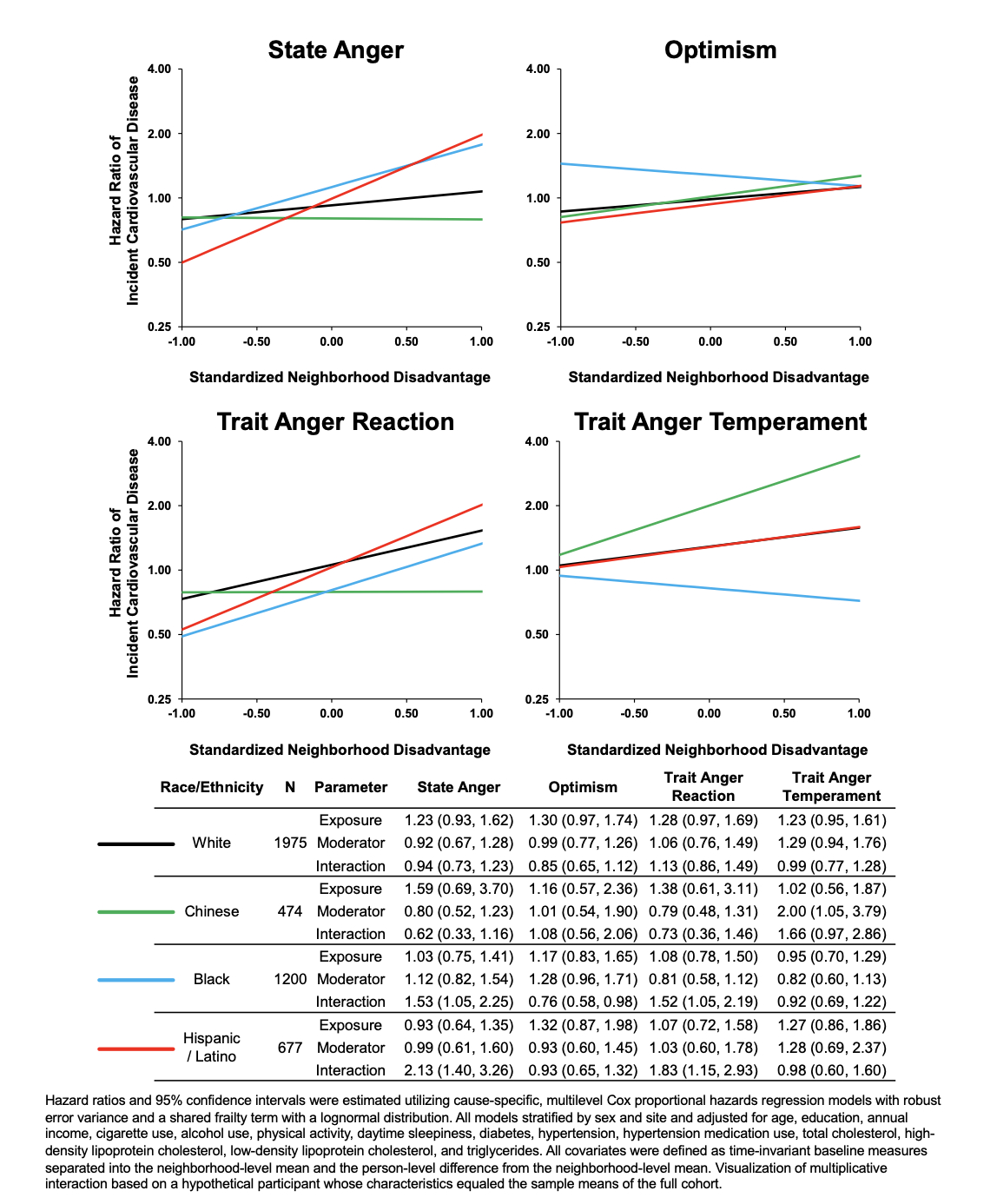Final ID: P3142
Moderating Role of Psychosocial Risk and Resilience in the Relationship Between Neighborhood Disadvantage and Incident Cardiovascular Disease Across Ethnoracial Groups: MESA Cohort 2000-2019
Abstract Body: Introduction: Cardiovascular disease (CVD) is a leading cause of morbidity and mortality in the U.S., with neighborhood disadvantage as a well-established risk factor. Emerging evidence indicates a role for psychosocial risk and resilience factors in influencing these relationships, but the interplay between environmental and psychosocial factors across ethnoracial groups is poorly understood. This study examined whether psychosocial factors moderated the relationship between neighborhood disadvantage and person-level incident CVD in a multiracial, multiethnic cohort.
Methods: We examined data from 4,326 participants in the Multi-Ethnic Study of Atherosclerosis (MESA) study who were free of CVD at baseline and were assessed between July 17, 2000 and February 4, 2012. The exposure was neighborhood disadvantage quantified by the Area Deprivation Index. Moderators were optimism measured by the Life Orientation Test revised and anger measured by the State-Trait Anger Expression Inventory which includes subscales state anger, trait anger temperament, and trait anger reaction. We used covariate-adjusted, cause-specific, multilevel Cox models to generate hazard ratios and 95% CI for four self-identified ethnoracial groups—Black, Chinese, Hispanic/Latino[g1] , and White.
Results: Mean age at baseline was 62.6 years old (10.0 SD) and 53.2% of participants were female. Only among Black participants did higher optimism levels mitigate the effect of neighborhood disadvantage on incident CVD (Figure 1). In Black and Hispanic/Latino participants, higher levels of state anger and trait anger reactivity magnified the association between neighborhood disadvantage and incident CVD, while among Chinese participants, a more angry temperament exhibited a similar effect. The interaction between environmental and psychosocial factors was not statistically significant among White participants.
Conclusion: Our findings support the need for CVD interventions that address neighborhood socioeconomic and psychosocial characteristics while considering the sociocultural differences between ethnoracial groups.
Methods: We examined data from 4,326 participants in the Multi-Ethnic Study of Atherosclerosis (MESA) study who were free of CVD at baseline and were assessed between July 17, 2000 and February 4, 2012. The exposure was neighborhood disadvantage quantified by the Area Deprivation Index. Moderators were optimism measured by the Life Orientation Test revised and anger measured by the State-Trait Anger Expression Inventory which includes subscales state anger, trait anger temperament, and trait anger reaction. We used covariate-adjusted, cause-specific, multilevel Cox models to generate hazard ratios and 95% CI for four self-identified ethnoracial groups—Black, Chinese, Hispanic/Latino[g1] , and White.
Results: Mean age at baseline was 62.6 years old (10.0 SD) and 53.2% of participants were female. Only among Black participants did higher optimism levels mitigate the effect of neighborhood disadvantage on incident CVD (Figure 1). In Black and Hispanic/Latino participants, higher levels of state anger and trait anger reactivity magnified the association between neighborhood disadvantage and incident CVD, while among Chinese participants, a more angry temperament exhibited a similar effect. The interaction between environmental and psychosocial factors was not statistically significant among White participants.
Conclusion: Our findings support the need for CVD interventions that address neighborhood socioeconomic and psychosocial characteristics while considering the sociocultural differences between ethnoracial groups.
More abstracts on this topic:
A Qualitative Study of Perspectives on South Asian Dietary Practices: Exploring a Framework for Culturally Tailored Food-is-Medicine Interventions
Kaloth Srivarsha, Fitzgerald Nurgul, Bacalia Karen Mae, Kalbag Aparna, Setoguchi Soko
A Focus for Improvement - Factors for Lab Adherence in a Pediatric Preventive Cardiology ProgramHolsinger Hunter, Porterfield Ronna, Taylor Makenna, Dresbach Bethany, Seipel Brittany, Igwe Chukwuemeka, Alvarado Chance, Tran Andrew

